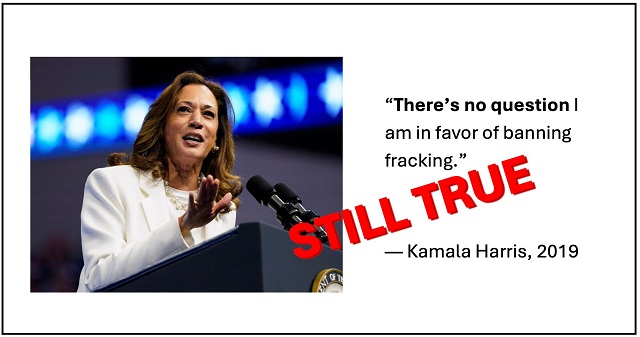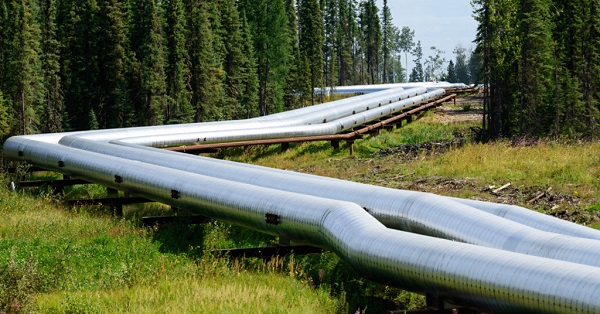Energy
Kamala Harris is still for banning fracking—as is everyone who advocates the net-zero agenda

From Energy Talking Points
By Alex Epstein
Myth: Kamala Harris used to be for banning fracking, but now she supports fracking.
Truth: Kamala Harris is still for banning fracking—because she is still for the net-zero agenda that requires banning fracking along with all other fossil fuel activities.
- Kamala Harris, who in 2019 said, “There is no question I am in favor of banning fracking,” now tells voters in fracking-dependent states like Pennsylvania that she is no longer wants to ban fracking.They shouldn’t believe her, since Harris’s net-zero agenda requires banning fracking.¹
- To know what to make of Harris’s reversal on a fracking ban, we need to first recognize that banning fracking would have been one of the most harmful policies in US history. It would have destroyed 60% of our oil production and 75% of our natural gas production.²
- Fracking is very likely the single most beneficial technological development of the last 25 years. By extracting cheap, abundant oil and natural gas from once useless rock, it has made energy far cheaper than it would otherwise be.
- Fracking and agriculture: The availability of food is highly determined by the cost of oil, which powers crucial machinery, and gas, which is the basis of the fertilizer that allows us to feed 8 billion people. Thanks to fracking, the world is far better fed than it would otherwise be.
- Given how life-giving fracking is to humanity and how essential it is to the prosperity and security of the US, any politician who has ever suggested banning fracking should be considered an energy menace until and unless they issue a deeply reflective apology.
- Harris and others who have advocated banning fracking should apologize along the following lines: “I called for banning something crucial because I listened only to exaggerated claims about its negatives and ignored its huge benefits. I am deeply sorry, and pledge to do better.”
- Someone who comes to understand why it’s wrong to ban fracking—because the benefits you would destroy are far greater than the harms you would avoid—should also understand that the same problem exists with the broader anti-fossil-fuel, “net zero” agenda.
- Harris has not apologized whatsoever for her support of a murderous fracking ban.And far from questioning the anti-fossil-fuel, “net zero” agenda, she has remained 100% committed to it.
Which means she’s an enemy of not just fracking but all fossil fuel use.
- The guiding energy goal of Biden/Harris is “net zero by 2050”—rapidly banning activities that add CO2 to the atmosphere.Since there’s no scalable way to capture CO2, burning fossil fuels necessarily means more CO2.
“Net zero” = “ban most fossil fuel use”—including fracking.³
- Given that “net zero by 2050” requires banning virtually all fossil fuel activity, the whole conversation about whether Kamala Harris wants to ban fracking is absurd.You can’t be for fracking and for net-zero anymore than you can be for penicillin and for banning all antibiotics.
- For “net zero by 2050” advocates there’s no question of if they want to ban particular fossil fuel activities such as fracking in the next 25 years, just when and in what order.If Harris doesn’t try to ban fracking soon she’ll just try to ban other vital fossil fuel activities.
- The Biden-Harris administration has already shown us that they will try to do everything they can to ban fossil fuels in pursuit of net-zero—and that they will only be limited by pro-fossil-fuel political opponents’ opposition and the resistance of voters.
- Both Biden and Harris made it clear when campaigning that their guiding energy goal was “net zero by 2050” and that meant rapidly banning fossil fuels.Biden: “I guarantee you, we’re going to end fossil fuel.” Harris’s cosponsored Green New Deal called for banning fossil fuels.⁴
- When they entered office, Biden and Harris continued to make “net zero by 2050” their guiding goal by rejoining the Paris Agreement that committed us to it and by announcing a “whole of government” focus on “climate”—code for: rapidly getting rid of fossil fuels.⁵
- In action after action, the Biden-Harris administration has shown us that it will do anything it can get away with politically to rapidly eliminate fossil fuels: pipeline blocking, Federal leasing bans, LNG prohibitions, power plant shutdowns, EV mandates, SEC rules, etc, etc.
8 ways the Biden administration is working to increase gasoline prices
·Jun 14The Biden administration claims that draining the Northeast Gasoline Supply Reserve shows its commitment to low gas prices.
Read full story - Americans have already paid a high price for the Biden-Harris administration’s net-zero agenda—high energy bills, power shortages, and inflation.But we’d be paying a far higher price had pro-fossil-fuel politicians and voters not opposed and dramatically slowed the agenda.⁶
- Most of what Biden-Harris have tried to do to rapidly eliminate fossil fuel use has been, thankfully, slowed by opposition: lawsuits over power plant shutdowns, courts reversing illegal leasing bans, etc.Without this opposition they would have already caused energy ruin.⁷
- Consider: America desperately needs more reliable power plants given huge demand from AI and (Biden-mandated) EVs.But the Biden-Harris EPA has tried to shut down all coal—1/6 of reliable capacity!
Were it not for Biden-Harris opponents we’d already have a 3rd-world grid.⁸
How EPA’s power plant rule will destroy our grid
·May 224 reasons EPA’s power plant rule will destroy our grid:
Read full story - Harris tries to act reassure us that she’s “moderate” because Biden-Harris hasn’t destroyed oil and gas—e.g., fracking is allowed and oil production has actually increased.But that’s because opposition has moderated her insanely destructive net-zero ambitions.
- The only way Kamala Harris can validly convince the public that she’s not an energy threat is to renounce not only her support of a fracking ban but of the “net zero” agenda—and to correct the anti-fossil-fuel bias that leads to both of these murderous policy ideas.
- Whenever you hear a politician claim to be a friend of oil and gas, fracking, or any other aspect of fossil fuels, ask one simple question: Do you renounce the “net zero” agenda?If not, they will work to destroy fossil fuels—and with them our energy, prosperity, and security.
Dan McTeague
Will this deal actually build a pipeline in Canada?

By Dan McTeague
Will Carney’s new pipeline deal actually help get a pipeline built in Canada? As we said before, the devil is in the details.
While the establishment and mainstream media cheer on the new pipeline agreement, there are specific details you need to be aware of.
Dan McTeague explains in his latest video.
Energy
Canada following Europe’s stumble by ignoring energy reality

Family in Spain eating by candlelight during a blackout, April 2025
From Resource Works
Canada’s own 2024 grid scare proves we’re on the same path unless we change course.
Europe’s green-energy unraveling is no longer a distant cautionary tale. It’s a mirror — and Canada is already seeing the first cracks.
A new Wall Street Journal investigation lays out the European story in stark detail: a continent that slashed emissions faster than anyone else, only to discover that doing so by tearing down firm power before its replacement existed comes with brutal consequences — collapsing industry, sky-high electricity prices, political fragmentation, and a public increasingly unwilling to subsidize wishful thinking.
The tragedy isn’t that Europe tried to decarbonize quickly.
The tragedy is how they did it: by insisting on an “or” transition — renewables or fossil fuels — instead of what every energy-literate nation outside Europe pursued: renewables and fossil fuels, working together while the system evolves.
And here’s the uncomfortable truth:
Canada has already had its first European-style crisis. It happened in January 2024.
Canada’s early warning: the January 2024 electricity crunch
Most people have already forgotten it, because our political class desperately wanted you to. But in January 2024, Western Canada came within a whisker of a full-blown energy security breakdown. Alberta, Saskatchewan, and B.C. were stretched to their limit. The grid was under cascading stress. Contingency plans were activated. Alberta came terrifyingly close to rolling blackouts.
It wasn’t caused by climate change. It wasn’t caused by a mysterious cyberattack.
It was caused by the same structural brittleness now crippling Europe:
- Insufficient firm power, after years of political messaging that we could “electrify everything” without adding real generating capacity.
- Overreliance on intermittent sources not backed by storage or gas.
- A planning system that punted risk into the future, betting the grid could be stretched indefinitely.
The January 2024 event was not a blip. It was a preview.
Our European moment in miniature.
But instead of treating it as the national wake-up call it should have been, B.C. did something telling — and deeply damaging.
The B.C. government’s response: attack the messenger
Just a couple of years ago, an economist publicly warned about the economic price of emerging system vulnerabilities due to a groaning stack of “clean economy” policies.
The B.C. government didn’t respond with data, evidence, or even curiosity. Instead, a cabinet minister used the safety of legislative privilege — that gold-plated shield against accountability — to launch nasty personal attacks on the economist who raised the concerns, which themselves had originated in the government’s own analysis.
No engagement.
No counter-analysis.
No willingness to consider the system risks.
Just slurs — the very definition of anti-intellectual governance.
It was a moment that told the whole story:
Too many policymakers in this province believe that energy systems obey politics, not physics.
Physics always gets the last word.
Europe shows us what political denial turns into
The WSJ reporting couldn’t be clearer about the consequences of that denial:
- Germany: highest domestic electricity prices in the developed world.
- U.K.: highest industrial electricity rates among major economies.
- Industrial flight: chemical plants closing, data centres frozen, major players hinting at exiting Europe entirely.
- Grid instability: wind farms paid tens of millions not to generate because the grid can’t handle it.
- Public revolt: rising support for parties rejecting the entire green-transition agenda.
- Policy whiplash: governments rushing to build gas plants they swore they’d never need.
Europe is now an object lesson in how good intentions, executed poorly, can produce the exact opposite of what was promised: higher prices, higher volatility, declining competitiveness, and a public ready to abandon climate policy altogether.
This is precisely what January 2024 warned us about — but on a continental scale.
The system cost we keep pretending doesn’t exist
Every serious energy expert knows the truth Europe is now living: intermittent renewables require massive amounts of redundant capacity, storage, and backup generation. That’s why the U.K. now needs 120 gigawatts of capacity to serve a demand previously met with 60–70 gigawatts, even though electricity use hasn’t meaningfully grown.
This is the math policymakers prefer not to show the public.
And it’s why B.C.’s refusal to have an honest conversation about firm power is so dangerous.
If we electrify everything without ensuring affordable and abundant natural gas generation, we’re not building a green future.
We’re building Europe, 10 years early.
The lesson for Canada — especially for B.C.
Here is what Europe and January 2024 together say, in one clear voice:
1. There is no energy transition without firm power.
Renewables are part of the system, but they don’t run the system. Natural gas does. Hydro does. Nuclear does. Pretending otherwise is how you end up with rolling blackouts.
2. Political denial makes crises worse.
When ministers attack economists instead of answering them, it signals that ideology is running the show. Europe learned the cost of that. We will too, unless we change course.
3. Affordability is the foundation of public consent.
Europe lost the room. Once people see their bills double while factories close, the climate agenda becomes politically radioactive.
4. B.C. has an advantage Europe would kill for.
Europe dreams of having an abundant, local, low-carbon firm-power fuel like northeastern B.C.’s natural gas. We treat it like a political liability. That’s not strategy. It’s negligence.
5. The transition will fail if we don’t treat electricity like the national security asset it is.
Without energy, there is no industry.
Without industry, there is no prosperity.
Without prosperity, there is no climate policy that survives the next election cycle.
What we need now
Canada must embrace an “and” strategy:
Renewables and natural gas. Electrification and realism. Climate ambition and economic competitiveness.
January 2024 showed us the future in a flash. Europe shows us the end state if we keep ignoring the warning.
We can still choose something better. But only if we stop pretending that energy systems bend to political narratives — and start treating them with the seriousness they demand.
Resource Works News
-

 MAiD1 day ago
MAiD1 day agoFrom Exception to Routine. Why Canada’s State-Assisted Suicide Regime Demands a Human-Rights Review
-

 Automotive2 days ago
Automotive2 days agoPower Struggle: Governments start quietly backing away from EV mandates
-

 Business1 day ago
Business1 day agoCarney government should privatize airports—then open airline industry to competition
-

 Business2 days ago
Business2 days agoNew Chevy ad celebrates marriage, raising children
-

 Business1 day ago
Business1 day agoWhat’s Going On With Global Affairs Canada and Their $392 Million Spending Trip to Brazil?
-

 Censorship Industrial Complex2 days ago
Censorship Industrial Complex2 days agoA Democracy That Can’t Take A Joke Won’t Tolerate Dissent
-

 Energy1 day ago
Energy1 day agoCanada following Europe’s stumble by ignoring energy reality
-

 Censorship Industrial Complex2 days ago
Censorship Industrial Complex2 days agoFrances Widdowson’s Arrest Should Alarm Every Canadian










